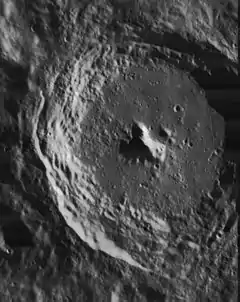.png.webp) LRO image | |
| Coordinates | 70°36′S 5°30′W / 70.6°S 5.5°W |
|---|---|
| Diameter | 114 km |
| Depth | 5.0 km |
| Colongitude | 7° at sunrise |
| Eponym | Theodorus Moretus |

Moretus is a lunar impact crater located in the heavily cratered highland region near the south pole of the Moon.
South of Moretus, the crater Short is located, while to the north is Cysatus. To the northwest lies Gruemberger, and Curtius is located to the northeast. Due to the location near the lunar limb, the crater appears oblong because of foreshortening. The crater is named after the 17th-century Flemish mathematician and geometer Theodorus Moretus.
The rim of the crater has a wide, terraced inner wall, and a complex outer rampart. The floor has been partly resurfaced and is relatively flat. In the middle is a central mountain formation that rises about 2.1 kilometers above the surrounding floor.
Satellite craters
By convention these features are identified on lunar maps by placing the letter on the side of the crater midpoint that is closest to Moretus.
| Moretus | Latitude | Longitude | Diameter |
|---|---|---|---|
| A | 70.4° S | 13.8° W | 32 km |
| C | 72.6° S | 11.2° W | 17 km |
References
- Andersson, L. E.; Whitaker, E. A. (1982). NASA Catalogue of Lunar Nomenclature. NASA RP-1097.
- Blue, Jennifer (July 25, 2007). "Gazetteer of Planetary Nomenclature". USGS. Retrieved 2007-08-05.
- Bussey, B.; Spudis, P. (2004). The Clementine Atlas of the Moon. New York: Cambridge University Press. ISBN 978-0-521-81528-4.
- Cocks, Elijah E.; Cocks, Josiah C. (1995). Who's Who on the Moon: A Biographical Dictionary of Lunar Nomenclature. Tudor Publishers. ISBN 978-0-936389-27-1.
- McDowell, Jonathan (July 15, 2007). "Lunar Nomenclature". Jonathan's Space Report. Retrieved 2007-10-24.
- Menzel, D. H.; Minnaert, M.; Levin, B.; Dollfus, A.; Bell, B. (1971). "Report on Lunar Nomenclature by the Working Group of Commission 17 of the IAU". Space Science Reviews. 12 (2): 136–186. Bibcode:1971SSRv...12..136M. doi:10.1007/BF00171763. S2CID 122125855.
- Moore, Patrick (2001). On the Moon. Sterling Publishing Co. ISBN 978-0-304-35469-6.
- Price, Fred W. (1988). The Moon Observer's Handbook. Cambridge University Press. ISBN 978-0-521-33500-3.
- Rükl, Antonín (1990). Atlas of the Moon. Kalmbach Books. ISBN 978-0-913135-17-4.
- Webb, Rev. T. W. (1962). Celestial Objects for Common Telescopes (6th revised ed.). Dover. ISBN 978-0-486-20917-3.
- Whitaker, Ewen A. (1999). Mapping and Naming the Moon. Cambridge University Press. ISBN 978-0-521-62248-6.
- Wlasuk, Peter T. (2000). Observing the Moon. Springer. ISBN 978-1-85233-193-1.